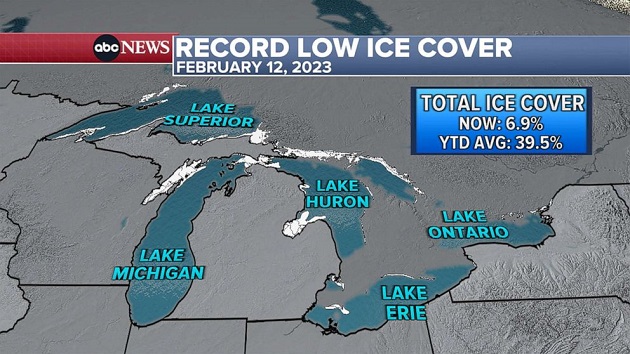(CLEVELAND, Ohio) — For the second day in a row, the Great Lakes are at a combined ice cover low.
On Feb. 13, the combined ice cover across the Great Lakes was 7.3%, breaking the old record from 2002. The historical average for ice cover season-to-date is 40%.
The region is nearing the average peak of ice season, but instead, ice levels are going down due to abnormally warm, near-record air temperatures.
Ice cover levels on Feb. 12:
Great Lakes Basin averages 39.5% ice cover. Currently it sits at a record low of 6.9%. The precious record is from 2012, with 7.9%.
Lake Superior has 5.5% ice cover, which is nearing the low from 1999.
Lake Michigan has a record low of 7.6% ice cover, beating the old record from just a few years ago in 2020.
Lake Huron has a record low of 12.6% ice cover, beating the old record from 1999.
Lake Erie has a tie for lowest ice cover with 1998, at 0.6%.
Lake Erie is the shallowest Great Lake and the smallest by volume. It is known for gaining and loosing ice quickest. So it is no great surprise, when looking at the drastic air temperature trend for the area, that a little more than a week ago the lake had more than 40% ice cover and is now less than 1% covered.
Lake Ontario currently sits at 1.6% ice cover and is nearing the record from 2012.
As February continues, colder air is expected to reach the Great Lakes. This should allow for ice cover to increase above record low levels, while staying abnormally low overall.
Is climate change involved in these numbers?
On average, ice coverage on the lakes has significantly declined in recent decades as average temperatures are increasing. In the Great Lakes regions, temperatures have warmed by as much as 5 degrees over the last 50 years.
Between 1973 and 2010, ice on the Great Lakes altogether declined 71%. Lake Ontario went down by 88%, Superior by 79%, and Michigan not far behind, recording a 77% ice loss over the 38-year timeframe. Lake Huron declined 62%, and Erie at 50%.
The maximum ice cover reached each year still shows an annual percent decrease, but it is less drastic, at a 22% decline for all lakes combined from 1970 to 2020.
Additionally, the variability of maximum ice cover is increasing over time. This makes sense when considering the weather patterns: big heat waves to big cold snaps leads to less ice and more ice, with the extremes occurring closer together.
In other words, the extreme from one year to the next is getting bigger and more frequent, which is an impact of climate change. That means even though this year is breaking records for low ice extent, next year or the year after could break records for max ice extent.
What low ice coverage affects
Low ice coverage has a wide range of impacts across industries and communities.
Hundreds of millions of tons of cargo are shipped on the lakes each year, a multi-billion dollar industry, and lower ice cover means shipping can operate longer throughout the year, increasing their profits.
Meanwhile, the Coast Guard can spend less time and fewer resources breaking ice and rescuing stranded ships since there is less ice cover, potentially saving taxpayer money.
Lower ice extent also means more evaporation, which means lower water levels. Not only does lower water levels negatively affect the commercial shipping industry, it can also affect hydroelectric plants, reducing their energy production — a cost that will trickle down to consumers when other means of energy production become necessary.
Less ice cover means more open-face water during winter, and this can lead to more lake-effect precipitation. For now, that means more lake-effect snowfall, but as temperatures continue to rise, this will lead to more lake-effect rainfall instead.
When there isn’t ice to dampen wave activity, there can be an increase to coastal erosion.
There is also a significant tourism industry that depends on the lakes icing over. Low ice extent can lead to a substantial negative impact on the tourism and recreation industry, such as ice fishing, and the businesses reliant on that.
When it comes to the ecosystem impact, the Upper Great Lakes are the most impacted by warmer waters throughout the year. Cold water fish are forced to compete with the warm water species that migrate farther north. Less ice can also leave the eggs of fish more exposed to the elements and lead to “dead zones,” where fish aren’t able to come to term.
Plus, with more heavy lake-effect precipitation, there can easily be more runoff with various nutrients loading into the lakes at higher levels, leading to more favorable conditions for toxic algal blooms.
Additionally, there are Indigenous communities who need ice cover to perform rituals.
And of course, safety is a bigger issue during low ice cover, because people who have been on the ice in years past may assume they can again without realizing how thin the ice that does exist is.
Copyright © 2023, ABC Audio. All rights reserved.












